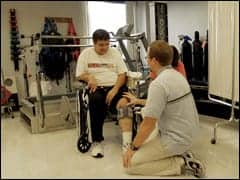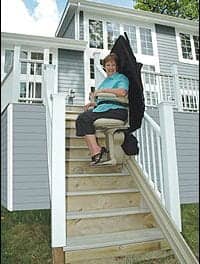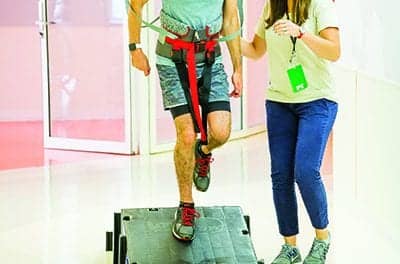When brain injuries cause spasticity in lower limbs and restrict joint mobility, casting can allow a patient to participate in rehabilitation.
by Naama Kenig, PT, DPT, and Shannon Motisi, PT, DPT
According to the Centers for Disease Control and Prevention, about 2% of the population are living with a disability due to brain injury.1 After an acquired brain injury, which may range from mild to severe, patients may benefit from time in an acute rehabilitation setting. One of the complications frequently seen after brain injury is the onset of spasticity.
Spasticity is defined as hyper-excitability of reflexes and over-activity of muscle groups. This occurs due to disruptions in pathways of the upper motor neurons and dysfunction of central nerve processes.2 Spasticity after brain injury can interfere with movement and therefore can impact mobility, self-care, positioning, and transfers. Also, spasticity and restrictions in joint mobility can lead to significant pain, which can impact a person’s ability to participate in rehabilitation.
Spasticity can be managed through pharmacological means or non-pharmacological means. The physiatrist determines the plan for pharmacological management, which may include the administration of oral medications such as baclofen, or with injections such as Botox or phenol. Physical therapists often utilize non-pharmacological interventions such as stretching, weight-bearing, serial casting, splinting, and electrical stimulation to manage spasticity.3 In acute rehabilitation, the treatment team works together to provide both pharmacological and non-pharmacological interventions, in conjunction with one another, to provide optimal management of spasticity.
Choosing Serial Casting
Serial casting is often utilized as a therapy tool in the inpatient rehabilitation setting for patients with severe brain injury.4,5 It is defined as the application of successive casts to a joint, set at submaximal range, for a prolonged stretch to the joint. Serial casting can be used to reduce spasticity, increase range of motion, prevent contractures, improve positioning, and improve mobility.6
In the lower extremities, serial casting may be applied at the ankle or the knee joint.7 At the ankle, an equino-varus deformity is the most common deformity that occurs due to spasticity. The plantarflexion and varus are due to overactivity of the related musculature, combined with the resting position of the foot when supine or in a non-weight-bearing position. At the knee, there may be a loss in range of motion due to either excessive flexion tone or excessive extension tone. Serial casting can be used to provide a stretch into either flexion or extension, to address the aforementioned limitations.
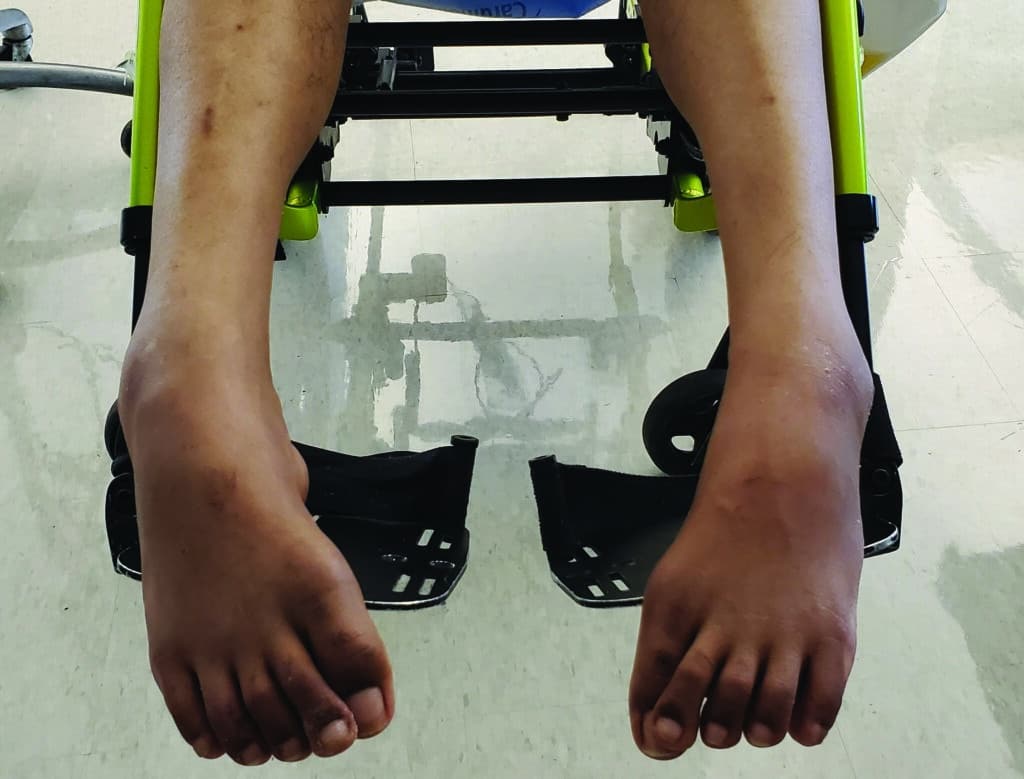
Prepping for Casting
When determining the need for serial casting, several aspects must be considered, including medical history, tolerance, ability to communicate, level of agitation, and skin integrity. Precautions to cast application include: current fractures, wounds, impaired circulation, and deep vein thrombosis.
Prior to cast application, therapists should take goniometric measurements of the joint’s range of motion. It is important to assess the range in a resting position, as well as the passive range of motion and active range of motion. Spasticity is measured using the Modified Ashworth Scale as well as the Modified Tardieu Scale, which has a higher test-retest and inter-rater reliability in adults with brain injury.8 The clonus score should be assessed as well. A thorough skin inspection must be performed prior to cast application to assess for any areas of skin breakdown or erythema. This information must be carefully documented in order to detect any possible changes post cast removal.
Casting Process
The patient is typically positioned on a treatment mat for lower extremity cast application. When applying a cast, the patient may be positioned in a prone or supine position, based on the patient’s tolerance. If supine, bolsters or wedges may be utilized in order to support the limb in the optimal position. Casting includes a partnership between two therapists: a “caster” and a “holder.” The “holder” provides the necessary sustained stretch, while the “caster” applies the cast. It is important to work in a quick and efficient manner so that the holder is able to sustain a sufficient stretch, in optimal alignment, and not fatigue.
A terry cloth stockinette is donned over the limb, encapsulating the joint. The fabric has some elasticity and provides padding. It is available in different measurements to accommodate differently sized limbs. Care must be taken to ensure it is not restrictive and will not compromise blood flow. Following the stockinette layer, layers of cotton cast padding are applied. Several layers are applied in order to provide proper padding, and extra layers are added at areas of bony prominences to reduce the risk of pressure points within the cast.
Finally, the casting tape is applied. The casting tape may be in the form of a plaster or fiberglass. While a plaster cast may be easier to mold, and is the cheaper option, fiberglass casts are lighter, stronger, and more durable. Plaster casts also take significantly longer to dry and set, and there is a risk of the plaster breaking or cracking while hardening.
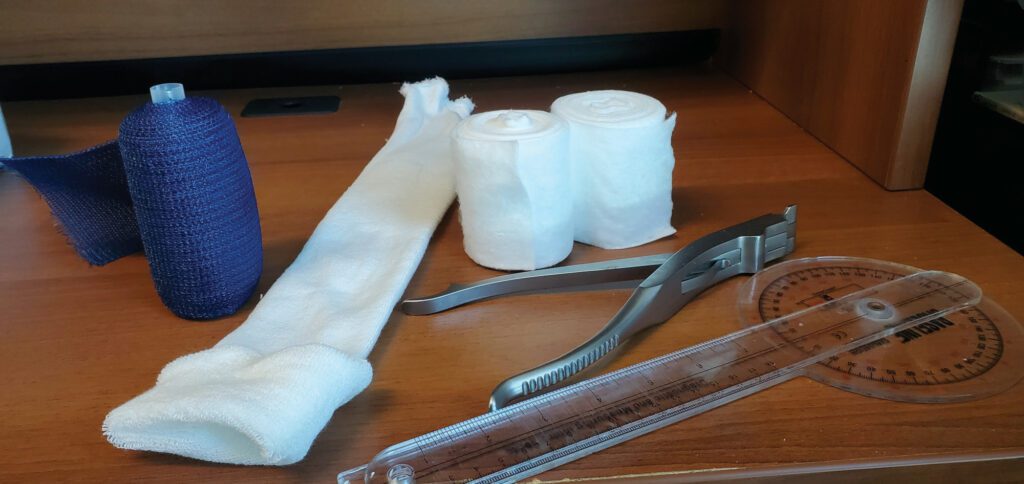
Assessing After Application
After the cast is applied, capillary refill at the toes is assessed to ensure adequate blood supply to the extremity. Other evaluations performed after cast application include assessing coloration and temperature of the foot and noting any swelling of the limb. A finger must be able to be inserted into the cast around the circumference of both proximal and distal aspects of the cast, to ensure the cast does not become too restrictive.
These assessments are completed every two hours while the cast is donned. Nursing staff, as well as family and caregivers, are trained in performing these assessments as well.
As some level of edema is likely to occur while the cast is donned, it is recommended to avoid prolonged periods with the limb placed in a dependent position. Intermittent elevation of the lower extremity may help reduce the amount of swelling that will occur.
Cast Removal and Reapplication
When the cast is removed, a thorough skin inspection is completed to take note of any areas of skin breakdown. Goniometric measurements as well as spasticity measurements are reassessed. If positive change is noted and no skin breakdown has occurred, the next serial cast may be applied.
In our inpatient setting, we aim to ideally have the casts applied for five consecutive days. We typically remove the casts prior to the weekend, to reduce the chances of any concerns or issues arising over the weekend. When removed, a maintenance plan is determined in order to sustain any gains achieved with casting. This short-term plan typically consists of utilizing multi-podus boots, with continued skin checks every two hours.
If there are no skin issues over the weekend, and casting is still indicated, another round of casting will be completed at the start of the next week. This cycle of casting will continue as long as objective gains are made and there are no negative side effects, such as skin issues, excessive autonomic storming, or behavioral issues.
Maintaining Range
When the casting process is completed, it is important to maintain the new range that was achieved.9 There are several bracing options that are utilized. The serial cast may be bi-valved and then reapplied as a resting splint. A multi-podus boot can also help maintain range achieved. However, its use is somewhat limited if the patient continues to have significant range limitations. As a multi-podus boot does not allow for custom fitting, there may be areas of excessive pressure which can increase the risk of skin breakdown. Another option is dynamic splinting. Dynamic splints provide low-load prolonged duration stretch at end ranges of motion. The goal of dynamic splinting is to not only maintain rage, but to continue to improve it.10
The decision to cast a patient while they are in inpatient rehabilitation can be a challenging one. The casts may limit functional mobility in some capacity, and may make interventions such as gait training more challenging. They may also create more challenges for the caregiver during transfers, positioning, and ADLs. The treating team must weigh the pros and cons of casting, and consider the length of stay and goals in acute rehabilitation when making the determination to cast. Therefore, the time frame and number of serial casts applied in an inpatient setting may look differently than when done in an outpatient setting.
Naama Kenig, PT, DPT, graduated with her doctorate in Physical Therapy from SUNY Downstate Medical Center in 2013. She currently is a clinical therapy manager of the brain injury unit in Kessler Institute for Rehabilitation in West Orange, NJ. She is a board-certified clinical specialist in neurologic physical therapy.
Shannon Motisi, PT, DPT, graduated with her doctorate in Physical Therapy from Quinnipiac University in 2010. She currently is a clinical specialist in the brain injury unit in Kessler Institute for Rehabilitation in West Orange, NJ. She is a board-certified clinical specialist in neurologic physical therapy. For more information, contact [email protected].
References
1. Centers for Disease Control and Prevention.CDC: TBI Data and Statistics. Centers for Disease Control and Prevention.Published April 10, 2019. http://www.cdc.gov/traumaticbraininjury/data/
2. Enslin JMN, Rohlwink UK, Figaji A. Management of Spasticity After Traumatic Brain Injury in Children. Front Neurol. 2020 Feb 21;11:126. doi: 10.3389/fneur.2020.00126. PMID: 32153498; PMCID: PMC7047214.
3. Lee SJ, Sung IY, Jang DH, Yi JH, Lee JH, Ryu JS. The effect and complication of botulinum toxin type a injection with serial casting for the treatment of spastic equinus foot. Ann Rehabil Med. 2011;35(3):344-353. doi:10.5535/arm.2011.35.3.344
4. Singer BJ, Singer KP, Allison GT. Evaluation of extensibility, passive torque and stretch reflex responses in triceps surae muscles following serial casting to correct spastic equinovarus deformity. Brain Inj. 2003;17(4):309-324. doi:10.1080/0269905021000013237
5. Mortenson PA, Eng JJ. The use of casts in the management of joint mobility and hypertonia following brain injury in adults: a systematic review. Phys Ther. 2003;83(7):648-658.
6. Singer BJ, Singer KP, Allison GT. Evaluation of extensibility, passive torque and stretch reflex responses in triceps surae muscles following serial casting to correct spastic equinovarus deformity. Brain Inj. 2003;17(4):309-324. doi:10.1080/0269905021000013237
7. Leung J, Harvey LA, Moseley AM. An intensive programme of passive stretch and motor training to manage severe knee contractures after traumatic brain injury: a case report. Physiother Can. 2013;65(3):223-228. doi:10.3138/ptc.2012-29
8. Platz T, Eickhof C, Nuyens G, Vuadens P. Clinical scales for the assessment of spasticity, associated phenomena, and function: a systematic review of the literature. Disabil Rehabil. 2005;27(1-2):7-18. doi:10.1080/09638280400014634
9. Leung J, Stroud K. Long-Term Resolution of Severe Ankle Contractures Using Botulinum Toxin, Serial Casting, Splinting, and Motor Retraining. Physiother Can. 2018;70(2):152-159. doi:10.3138/ptc.2016-76
10. Curran S, Willis FB. Chronic Ankle Contracture Reduced: A Case Series. The Foot and Ankle Online Journal. Published online July 1, 2011. Doi:10.3827/faoj.2011.0407.0002


